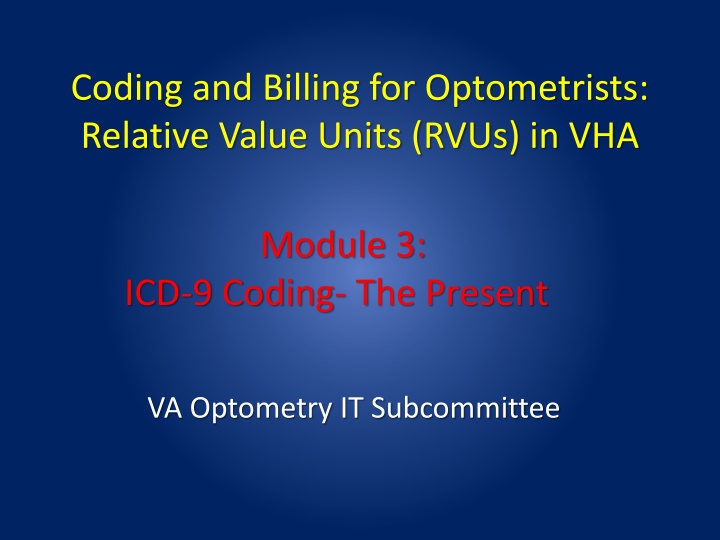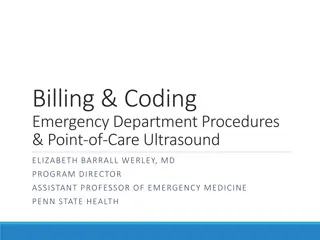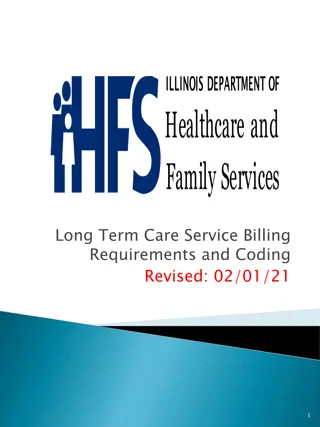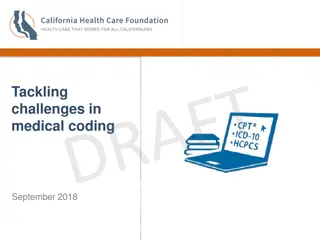Coding and Billing for Optometrists: Relative Value Units (RVUs) in VHA
Optometry is now included in the Relative Value Unit (RVU) based VA productivity methodology. Learn about the different types of RVUs used, including DSS RVUs for budgeting and CMS RVUs for workload and exam complexity coding. Understand how physician productivity is calculated using CPT coding and RVUs per physician provider FTEE within VA. Explore VA wRVU data sources and methods for various healthcare professionals transmitting outpatient and inpatient encounter workload with CPT coding.
Download Presentation

Please find below an Image/Link to download the presentation.
The content on the website is provided AS IS for your information and personal use only. It may not be sold, licensed, or shared on other websites without obtaining consent from the author.If you encounter any issues during the download, it is possible that the publisher has removed the file from their server.
You are allowed to download the files provided on this website for personal or commercial use, subject to the condition that they are used lawfully. All files are the property of their respective owners.
The content on the website is provided AS IS for your information and personal use only. It may not be sold, licensed, or shared on other websites without obtaining consent from the author.
E N D
Presentation Transcript
Coding and Billing for Optometrists: Relative Value Units (RVUs) in VHA Module 3: ICD-9 Coding- The Present VA Optometry IT Subcommittee
Authors Ballinger, Rex OD- Baltimore, MD Cordes, Matthew OD- The Villages, FL Fuhr, Patti OD, PHD- Salisbury, NC Ihrig, Carolyn OD- Buffalo, NY Katzenberger, Ann OD- American Lake, WA Kawasaki, Brian OD- Las Vegas, NV Lazarou, Zoe OD- Baltimore, MD Ryan, Raymond OD- Eureka, CA Whitesell, Bethany- Fayetteville, AR Zimbalist, Richard OD- Columbia, MO
Background Optometry is now included in the Relative Value Unit (RVU) based VA productivity methodology: DSS (Decision Support System) RVU (do not confuse with clinical decision support systems) CMS RVU (Relative Value Unit) system (VA specific) These systems are a costs accounting and clinical activity relational database system. All patient services will need to be correctly and accurately documented to ensure proper resource allocation and utilization. Resources include labor, equipment, support and other expenses.
VA Relative Value Unit (RVUs) Quick Review There are two different types of RVUs used in VA 1. DSS RVUs used for budgeting, cost accounting,and workload all of which are time related -This is directly related to stop codes, clinic appointment set up, and RVU times assigned at the DSS level. 2. CMS RVUs which are used to capture workload times as well as exam complexity coding -This is related to CPT codes!! -This is the RVU measure in the Office of Productivity, Efficiency and Staffing (OPES).
Background All optometrists who have outpatient and inpatient PCE (Patient Care Encounter) encounter workload with CPT coding is used in calculating physician productivity within VA. However, this applies to paid clinicians only. Productivity is expressed in Relative Value Units (RVUs) per physician provider FTEE that is dedicated to clinical duties.
VA wRVU Data Sources and Methods Physicians, chiropractors, optometrists, podiatrists, and psychologists who are transmitting outpatient and inpatient PCE (Patient Care Encounter) encounter workload with CPT coding which is used in calculating physician productivity (wRVUs). The database contains workload for VA PAID physicians, In-House FEE physicians, residents not assigned to providers on encounter forms, without compensation physician providers (WOCs) and contract physician providers (DSS-RVUs).
Understand YOU CAN T BILL FOR WHAT YOU DO YOU CAN ONLY BILL FOR WHAT IS DOCUMENTED YOU CAN T GET PROPER CREDIT FOR YOUR WORKLOAD UNLESS YOU CODE CORRECTLY and are MAPPED correctly YOUR CODING MUST BE TIMELY!! Your DSS workload is captured monthly- your encounters must be in by the monthly deadline or your work is NOT captured and never will be!!!
CPT Codes This is the key to developing the correct RVU data. Be sure you carefully document all your CPT codes. We covered all of the pertinent CPT code information for you in the CPT training module. These codes must be supported by your diagnosis codes which we will cover in this module
ICD Codes ICD: The International Statistical Classification of Diseases It is an international "standard diagnostic tool for epidemiology, health management and clinical purposes". ICD is published by the World Health Organization (WHO) and used worldwide for morbidity and mortality statistics, reimbursement systems, and automated decision support in health care
ICD-9 CM International Classification of Diseases, Clinical Modification (ICD-9-CM) is an adaption created by the U.S. National Center for Health Statistics (NCHS) and used in assigning diagnostic and procedure codes associated with inpatient, outpatient, and physician office utilization in the United States. The International Classification of Diseases (ICD) is designed to promote international comparability in the collection, processing, classification, and presentation of mortality statistics.
2014 Index of ICD-9 Codes 001-139 Infectious And Parasitic Diseases 140-239 Neoplasms 240-279 Endocrine, Nutritional And Metabolic Diseases, And Immunity Disorders 280-289 Diseases Of The Blood And Blood-Forming Organs 290-319 Mental Disorders 320-389 Diseases Of The Nervous System And Sense Organs 390-459 Diseases Of The Circulatory System 460-519 Diseases Of The Respiratory System 520-579 Diseases Of The Digestive System 580-629 Diseases Of The Genitourinary System 630-679 Complications Of Pregnancy, Childbirth, And The Puerperium 680-709 Diseases Of The Skin And Subcutaneous Tissue 710-739 Diseases Of The Musculoskeletal System And Connective Tissue 740-759 Congenital Anomalies 760-779 Certain Conditions Originating In The Perinatal Period 780-799 Symptoms, Signs, And Ill-Defined Conditions 800-999 Injury And Poisoning V01-V91 Supplementary Classification Of Factors Influencing Health Status And Contact With Health Services E000-E999 Supplementary Classification Of External Causes Of Injury And Poisoning
Diseases Of The Nervous System And Sense Organs 320-389 Series 320-327 Inflammatory Diseases Of The Central Nervous System 330-337 Hereditary And Degenerative Diseases Of The Central Nervous System 338-338 Pain 339-339 Other Headache Syndromes 340-349 Other Disorders Of The Central Nervous System 350-359 Disorders Of The Peripheral Nervous System 360-379 Disorders Of The Eye And Adnexa 380-389 Diseases Of The Ear And Mastoid Process
2014 ICD-9 Eye Series Index 360 Disorders of the globe 361 Retinal detachments and defects 362 Other retinal disorders 363 Chorioretinal inflammations scars and other disorders of choroid 364 Disorders of iris and ciliary body 365 Glaucoma 366 Cataract 367 Disorders of refraction and accommodation 368 Visual disturbances 369 Blindness and low vision 370 Keratitis 371 Corneal opacity and other disorders of cornea 372 Disorders of conjunctiva 373 Inflammation of eyelids 374 Other disorders of eyelids 375 Disorders of lacrimal system 376 Disorders of the orbit 377 Disorders of optic nerve and visual pathways 378 Strabismus and other disorders of binocular eye movements 379 Other disorders of eye
ICD-9 Coding The following slides highlight the important issues regarding ICD-9 Coding. There are many more specific issues that are beyond the scope of this module. Please refer to the latest edition of the ICD-9- CM Official Guidelines for Coding and Reporting.
ICD-9 Coding For accurate reporting of ICD-9-CM diagnosis codes, the documentation should describe the patient's condition, using terminology which includes specific diagnoses as well as symptoms, problems, or reasons for the encounter. There are ICD-9-CM codes to describe all of these situations.
ICD-9 Coding The selection of codes 001.0 through 999.9 will frequently be used to describe the reason for the encounter. These codes are from the section of ICD-9-CM for the classification of diseases and injuries.
ICD-9 Coding Codes that describe symptoms and signs, as opposed to diagnoses, are acceptable for reporting purposes when an established diagnosis has not been diagnosed (confirmed) by the physician.
ICD-9 Coding ICD-9-CM provides codes to deal with encounters for circumstances other than a disease or injury.
Correct Coding with ICD-9 ICD-9-CM is composed of codes with either 3, 4, or 5 digits. Codes with 3 digits are included in ICD-9-CM as the heading of a category of codes that may be further subdivided by the use of fourth and/or fifth digits which provide greater specificity. A three-digit code is to be used only if it is not further subdivided. Where fourth-digit subcategories and/or fifth-digit sub- classifications are provided, they must be assigned. NOTE: A code is invalid if it has not been coded to the full number of digits required for that code.
Important! An ICD-9 code is invalid if it has not been coded to the full number of digits required for that code.
Correct ICD-9 Coding List first the ICD-9-CM code for the diagnosis, condition, problem, or other reason for encounter/visit shown in the medical record to be chiefly responsible for the services provided. List additional codes that describe any co- existing conditions.
Correct ICD-9 Coding Do not code diagnoses documented as "probable", "suspected," "questionable," "rule out," or working diagnosis. Rather, code the condition(s) to the highest degree of certainty for that encounter/visit, such as symptoms, signs, abnormal test results, or other reason for the visit
Chronic Diseases Chronic diseases treated on an ongoing basis may be coded and reported as many times as the patient receives treatment and care for the condition(s).
Correct Coding Code all documented conditions that coexist at the time of the encounter/visit, and require or affect patient care treatment or management. Do not code conditions that were previously treated and no longer exist. However, history codes (V10- V19) may be used as secondary codes if the historical condition or family history has an impact on current care or influences treatment.
Correct Coding Again, for patients receiving diagnostic services only during an encounter/visit, sequence first the diagnosis, condition, problem, or other reason for encounter/visit shown in the medical record to be chiefly responsible for the outpatient services provided during the encounter/visit. Codes for other diagnoses (e.g., chronic conditions) may be sequenced as additional diagnoses.
Correct Coding For patients receiving therapeutic services only during an encounter/visit, sequence first the diagnosis, condition, problem, or other reason for encounter/visit shown in the medical record to be chiefly responsible for the outpatient services provided during the encounter/visit.
Combination Code A combination code is a single code used to classify: Two diagnoses, or A diagnosis with an associated secondary process (manifestation), or A diagnosis with an associated complication
Combination Codes Are identified by referring to sub-term entries in the Alphabetic Index and by reading the inclusion and exclusion notes in the Tabular List. Assign only the combination code when that code fully identifies the diagnostic conditions involved or when the Alphabetic Index so directs. Multiple coding should not be used when the classification provides a combination code that clearly identifies all of the elements documented in the diagnosis.
Correct Coding When the combination code lacks necessary specificity in describing the manifestation or complication, an additional code should be used as a secondary code.
Combination Code Example 250.00 diabetes with 362.04- mild non- proliferative diabetic retinopathy More than one code from category 250 may be used with as many manifestation codes as are needed to fully describe the patient s complete diabetic condition
Combination Coding Certain conditions have both an underlying etiology and multiple body system manifestations due to the underlying etiology. For such conditions, the ICD-9-CM has a coding convention that requires the underlying condition to be sequenced first followed by the manifestation.
Other Descriptive Abbreviations NEC- Not Elsewhere Classifiable : This abbreviation in the index represents other specified when a specific code is not available for a condition, the index directs the coder to the other specified code in the tabular. NOS- Not Otherwise Specified : This abbreviation is the equivalent of unspecified.
Includes and Excludes Notes & Inclusion Terms Includes: This note appears immediately under a three-digit code title to further define, or give examples of, the content of the category. Excludes: An excludes note under a code indicates that the terms excluded from the code are to be coded elsewhere. Inclusion Terms: List of terms is included under certain four and five digit codes.
Other and Unspecified Codes Other Codes: These are for use when the information in the medical record provides detail for which a specific code does not exist Unspecified Codes: These are for use when the information in the medical record is insufficient to assign a more specific code
Etiology/Manifestation Convention Certain conditions have both an underlying etiology and multiple body system manifestations due to the underlying etiology. For such conditions, the ICD-9-CM has a coding convention that requires the underlying condition be sequenced first followed by the manifestation.
Etiology/Manifestation Convention Wherever such a combination exists, there is a use additional code note at the etiology code, and a code first note at the manifestation code. These instructional notes indicate the proper sequencing order of the codes, etiology followed by manifestation.
Etiology/Manifestation Convention The most commonly used etiology/manifestation combinations are the codes for Diabetes mellitus, category 250. For each code under category 250 there is a use additional code note for the manifestation that is specific for that particular diabetic manifestation. Should a patient have more than one manifestation of diabetes, more than one code from category 250 may be used with as many manifestation codes as are needed to fully describe the patient s complete diabetic condition.
Signs and Symptoms Codes that describe symptoms and signs, as opposed to diagnoses, are acceptable for reporting purposes when a related definitive diagnosis has not been established (confirmed) by the provider.
Conditions That are an Integral Part of a Disease Process Signs and symptoms that are associated routinely with a disease process should not be assigned as additional codes, unless otherwise instructed by the classification.
Conditions That are Not an Integral Part of a Disease Process Additional signs and symptoms that may not be associated routinely with a disease process should be coded when present.
Acute and Chronic Conditions If the same condition is described as both acute (subacute) and chronic, and separate subentries exist in the Alphabetic Index at the same indentation level, code both and sequence the acute (subacute) code first.
Reporting the Same Diagnosis Code More than Once Each unique ICD-9-CM diagnosis code may be reported only once for an encounter. This applies to bilateral conditions or two different conditions classified to the same ICD- 9-CM diagnosis code.
Glaucoma For types of glaucoma classified to subcategories 365.1-365.6, an additional code should be assigned from subcategory 365.7, Glaucoma stage, to identify the glaucoma stage. Codes from 365.7, Glaucoma stage, may not be assigned as a principal or first-listed diagnosis.
Glaucoma Stage Codes *365.71 Mild or early-stage glaucoma (defined as optic nerve abnormalities consistent with glaucoma but no visual field abnormalities on any white-on-white visual field test, or abnormalities present only on short-wavelength doubling perimetry) *365.72 Moderate stage glaucoma (optic nerve abnormalities consistent with glaucoma and glaucomatous visual field abnormalities in one hemifield, and not within 5 degrees of fixation) *365.73 Severe stage glaucoma, advanced stage glaucoma, end stage glaucoma (Optic nerve abnormalities consistent with glaucoma and glaucomatous visual field abnormalities in both hemifields, and/or loss within 5 degrees of fixation in at least one hemifield)
Indeterminate Stage Glaucoma Assignment of code 365.74, Indeterminate stage glaucoma, should be based on the clinical documentation. Code 365.74 is used for glaucomas whose stage cannot be clinically determined. This code should not be confused with code 365.70, Glaucoma stage, unspecified. Code 365.70 should be assigned when there is no documentation regarding the stage of the glaucoma.
Bilateral Glaucoma Stage with Different Stages When a patient has bilateral glaucoma and each eye is documented as having a different stage, assign one code for the type of glaucoma and one code for the highest glaucoma stage.
Bilateral Glaucoma with Different Types and Different Stages When a patient has bilateral glaucoma and each eye is documented as having a different type and a different stage, assign one code for each type of glaucoma and one code for the highest glaucoma stage.
Hypertensive Retinopathy Two codes are necessary to identify the condition. First assign the code from subcategory 362.11, Hypertensive retinopathy, then the appropriate code from categories 401-405 to indicate the type of hypertension.
Diabetic Retinopathy/ Diabetic Macular Edema Diabetic macular edema, code 362.07, is only present with diabetic retinopathy. Another code from subcategory 362.0, Diabetic retinopathy, must be used with code 362.07. Codes under subcategory 362.0 are diabetes manifestation codes, so they must be used following the appropriate diabetes code.
Age-related Macular Degeneration Atrophic (dry) AMD 362.51 Disciform AMD 362.52 Exudative (wet) AMD 362.52























